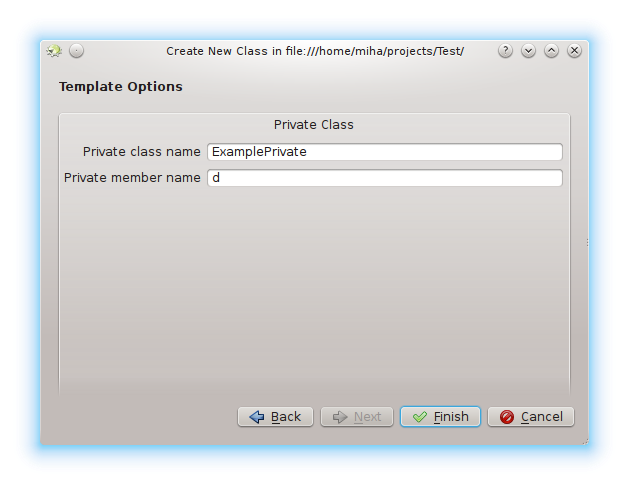KDevelop5/File template specification: Difference between revisions
| Line 62: | Line 62: | ||
* <tt>File</tt> is the path to the input file within the template archive | * <tt>File</tt> is the path to the input file within the template archive | ||
* <tt>OutputFile</tt> is the suggested output file name. The actual name can be set by the user, but this is the default value. It will be converted to lowercase if needed, so don't do in here. | * <tt>OutputFile</tt> is the suggested output file name. The actual name can be set by the user, but this is the default value. It will be converted to lowercase if needed, so don't do in here. | ||
The description file above results in a dialog page such as this | |||
[[File:KDevelop-template-output-files-dialog.png|center|alt=KDevelop template output files dialog|Assistant page for template output files]] | |||
=== Variables === | === Variables === | ||
Revision as of 12:47, 10 July 2012
Template language
Class templates use the Grantlee library for rendering templates. It has more features than KMacroExpander, the most important being loops and the ability to expose custom data types from C++ code to templates. The use of Grantlee makes templates more powerful, but also more difficult to write.
For information regarding Grantlee templates in general, refer to its documentation. Since Grantlee's template language is based on Django's, it might be useful to read the Django template documentation as well.
Example template template
There is a project template that creates a new project consisting of a single KDevelop class template. You can use it by starting a new project, choosing and installing this one. Proceeding to create a project using this template will create an example class template.
File structure
Like project templates, class templates are compressed directories, and they too contain a special description file and any number of content files. It is recommended that the description file has a .desktop extension instead of .kdevtemplate, although both are supported.
Unlike with project templates, not all files from the archive are copied to the output directory. Because Grantlee supports template inheritance and inclusions, class templates may contain helper files that only serve for convenience and produce no actual output. The actual output files have to be specified in the template description.
Description file format
The template descriptions files are normal .desktop files. They must contain a General section, as well as one section for each output file. In most cases, the template will have two output files for C++ classes and one output file for other languages. However, using separate user interface files and/or a shared d-pointer hierarchy can cause a class to need more files. Templates in KDevelop allow any number of output files.
Example
An example description for a template with three output files is below
[General]
Name=Private Pointer
Comment=C++ Class with a private D-pointer
Category=C++
Files=Header,PrivateHeader,Implementation
OptionsFile=options.kcfg
[Header]
Name=Public Header
File=class.h
OutputFile={{ name }}.h
[PrivateHeader]
Name=Private Header
File=class_p.h
OutputFile={{ name }}_p.h
[Implementation]
Name=Implementation
File=class.cpp
OutputFile={{ name }}.cpp
Entries
The Name and Comment entries are the same as in other .desktop files and can be translated. The Category is used for grouping when showing a list of templates to the user. It can contain more than one level, separated by slashes, but the first level should always be the language name.
The OptionsFile entry is optional, using it specifies configuration options for this template. For more information about template options, see Custom options.
Output files
The Files entry specifies template output files. It is a list of strings, where each element is the same as a name of a group in the description file. The corresponding group has three required entries
- Name is the user visible file name. It can be translated.
- File is the path to the input file within the template archive
- OutputFile is the suggested output file name. The actual name can be set by the user, but this is the default value. It will be converted to lowercase if needed, so don't do in here.
The description file above results in a dialog page such as this

Variables
The variables which are passed to class templates are described in the Expression error: Unrecognized word "extragear". API documentation.
Additional templates and filters
Custom options
Templates can expose configuration options to the user prior to the class generation. To do this, add a KConfig XT formatted file into the archive, and specify an OptionsFile entry in the template description file pointing to it.
OptionsFile=options.kcfg

For information about the options file format, see Using KConfig XT. Note that KDevelop only supports a subset of the KConfig XT specification. Only Int, Bool and String types are recognized, options with other types are ignored. Furthermore, only name, type, label and default attributes are used. The default value of options is rendered as a template, so it can include variables.
Here is an example options file that exposes two string options, useful for private pointers
<?xml version="1.0" encoding="UTF-8"?>
<kcfg xmlns="http://www.kde.org/standards/kcfg/1.0"
xmlns:xsi="http://www.w3.org/2001/XMLSchema-instance"
xsi:schemaLocation="http://www.kde.org/standards/kcfg/1.0
http://www.kde.org/standards/kcfg/1.0/kcfg.xsd">
<kcfgfile arg="true"/>
<group name="Private Class">
<entry name="private_class_name" type="String">
<label>Private class name</label>
<default>{{ name }}Private</default>
</entry>
<entry name="private_member_name" type="String">
<label>Private member name</label>
<default>d</default>
</entry>
</group>
</kcfg>
Just before creating the class, KDevelop will show an assistant dialog page, asking for the two options

The values the user sets for the two options will be available to the template as variables with names matching the entry names. In the private pointer example, the d-pointer declaration template might look like this
private:
{{ private_class_name }}* const {{ private_member_name }};
If the user accepts the default values, and the class name is Example, the rendered result of this snippet will be
private:
ExamplePrivate* const d;

